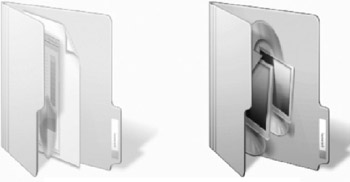What Are Hidden Files and Folders?
Windows contains a number of files that a beginner might find confusing, and that you don't want to delete or change accidentally . As a safety feature, these files are hidden , which means, by default, they don't show up in Windows Explorer and can't be opened, deleted, or moved in Windows Explorer unless you choose to make them visible. For example, the folder C:\Windows\Spool keeps track of technical information regarding your printers-stuff you mostly don't want to mess with. But if you open Computer, the C: drive, and then the Windows folder, you won't find the Spool folder. If you want to see C:\Windows\ System 32\Spool (and all the other hidden files and folders), follow these steps:
-
Choose Tools Folder Options from the menu bar of any Explorer window (press ALT to display the menu bar). The Folder Options dialog box appears.
-
Click the View tab. The Hidden Files section contains two radio buttons : Do Not Show Hidden Files And Folders and Show Hidden Files And Folders.
-
Click the Show Hidden Files And Folders radio button.
-
Click OK.
When hidden files and folders are shown, their icons appear as ghostly images, like the folder shown here on the left. The folder on the right is the normal folder (unhidden).
To hide files and folders again, repeat the preceding procedure, but select the Do Not Show Hidden Files And Folders radio button in Step 3.

Hidden files and folders usually don't play a significant role in the everyday life of the average computer user . For that reason, we recommend you leave them hidden whenever you are not working with one. This policy minimizes the chances you will alter or delete something important by accident .
Nonhidden files and folders contained in a hidden folder have an in-between status: they retain their original attributes and show up in Explorer windows if you move them to a nonhidden folder, but they are hidden in practice as long as they stay inside the hidden folder, because the path that connects them to the top of the folder tree includes a hidden link.
| Caution | A hidden file or folder shouldn't be considered secure. The Search command not only finds hidden files and folders, but anyone who finds your file by using this command can open it directly from the Search window (see "Searching for Files and Folders" later in the chapter). Also, you can see from the preceding discussion that viewing hidden files is not difficult. If other people use your computer and you don't want them to find particular files, you should encrypt those files, store them in your Documents folder ( assuming that your Windows user account has a password), or move them to a removable media device, such as a jump drive, USB key, or similar device, and keep it hidden in a more conventional way. See Chapter 6 for how to set up a password-protected user account with a private Documents folder, and Chapter 33 for a description of Windows' other security features. |
You can hide a file or folder by following this procedure:
-
Select the file or folder.
-
Click the Properties button on the toolbar, or right-click the file or folder and choose Properties from the shortcut menu. The Properties dialog box appears.
-
If it is not already selected, click the General tab. Near the bottom of the General tab is a list of attributes, one of which is Hidden.
-
Select the check box next to Hidden.
-
Click OK to make the Properties dialog box disappear.
To unhide the file, repeat the same steps, but deselect the Hidden check box.
EAN: 2147483647
Pages: 296